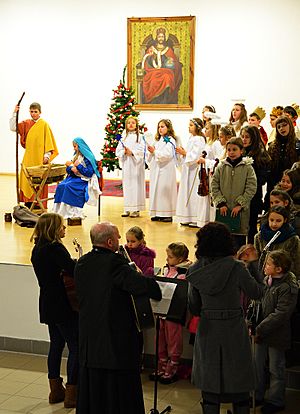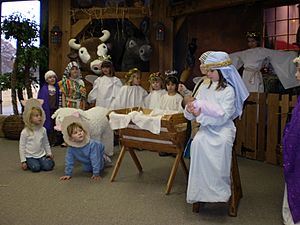Nativity play facts for kids

A Nativity play is a special play that tells the story of how Jesus was born. These plays are often performed around Christmas, which is a Christian holiday celebrating Jesus's birth. They help people remember the important events from the Bible about the first Christmas.
Contents
History of Nativity Plays
Nativity plays have been part of Christian traditions for a very long time.
Early Beginnings
One of the earliest examples of a Nativity play was in 1223. Saint Francis of Assisi held a special Christmas Eve service in a place called Greccio, Italy. He used a life-size nativity scene (also called a crib or creche) with real animals. This helped people imagine the scene of Jesus's birth. Many people think this was the first Nativity play.
Medieval Plays
Later, during the Middle Ages, Nativity plays became more formal. They were part of larger plays called mystery plays. These mystery plays often told many stories from the Bible. For example, some plays from the York Mystery Cycle in England showed the Nativity story. One very famous medieval Nativity play is called The Second Shepherds' Play.
Modern Traditions
Today, Nativity plays are still very popular around the world.
- In Germany, many Christmas Eve church services for children include a Krippenspiel, which means "crib play."
- In Latin America, plays called pastorelas are common. These plays show shepherds traveling to see the newborn Jesus. They often add funny parts, local traditions, and sometimes even modern jokes to the old story.
- In Belgium, puppet theaters sometimes perform Nativity plays in the weeks before Christmas.
- In Townsville, Queensland, Australia, there is a big annual Nativity play called "Stable on the Strand" held in a park.
- Many churches in the United States also put on large Nativity plays each year.
- These plays are also very popular in Eastern Europe, especially in Poland and Hungary.
Nativity Plays in Schools

Many schools, especially those with a Christian focus, and Sunday schools put on Nativity plays before the Christmas holidays. Children dress up as characters like Mary, Joseph, angels, shepherds, and wise men. Sometimes, a doll is used for baby Jesus, but sometimes a real baby plays the part! Parents, grandparents, and teachers usually come to watch these special performances.
In the United Kingdom, Nativity plays in public schools are changing. Some schools now put on more general Christmas plays to include children from different faiths. However, many schools still perform traditional Nativity plays or updated versions of the Christmas story.
Nativity Plays by Writers
Many famous writers have also written their own Nativity plays. Some of these include:
- Laurence Housman wrote Bethlehem in 1902.
- Dorothy L. Sayers wrote He That Should Come in 1938.
- Even the French writer Jean-Paul Sartre wrote a Nativity play called Bariona, ou le Fils du tonnerre in 1940. He wrote it while he was a prisoner during World War II.
See also
- Nativity scene - a visual display of the Nativity, often with figures
- Passion Play - a play about the last days of Jesus's life, usually performed at Easter

